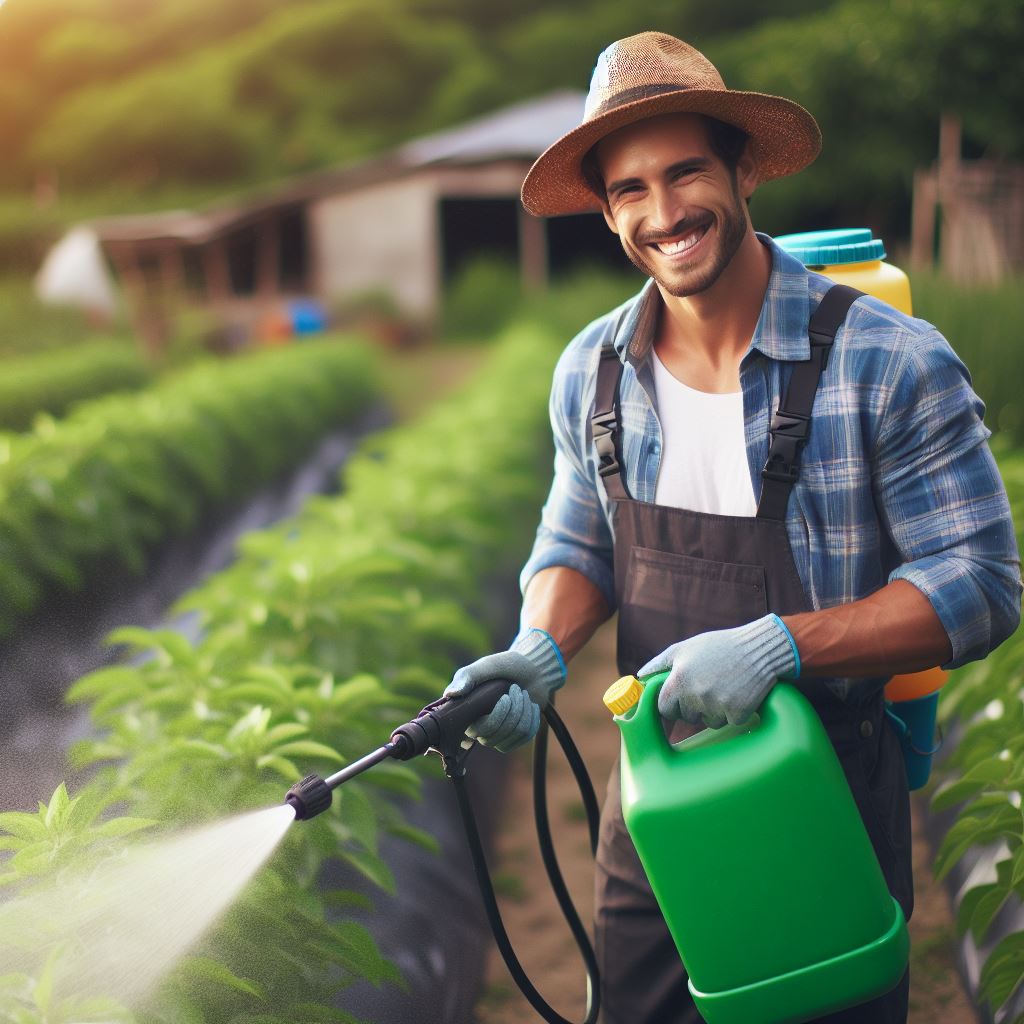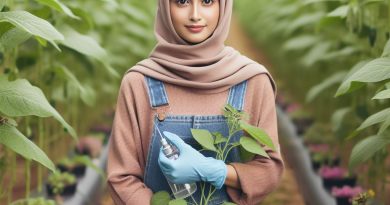Pesticide Use: Making the Right Choice
Last Updated on March 2, 2024
Introduction
As we explore “Pesticide Use Choice” allows farmers to align with consumer preferences for safe, residue-free produce.
Pesticides play a pivotal role in modern agriculture, safeguarding crops from pests and diseases.
Informed choices about pesticide use are crucial. Understanding their significance ensures sustainable and responsible farming practices.
Pesticides contribute to high-yield farming, protecting crops from destructive pests and preventing widespread diseases.
However, the misuse or uninformed use of pesticides poses environmental and health risks.
As consumers increasingly demand sustainable and environmentally friendly agricultural practices, farmers face the challenge of meeting these expectations while maintaining profitable operations.
Informed pesticide use allows farmers to align with consumer preferences for safe, residue-free produce.
The introduction of the significance of pesticide use in agriculture emphasizes the dual nature of these essential tools.
While crucial for crop protection and increased yields, the informed application is equally vital to ensure sustainability, environmental health, and consumer satisfaction.
This section will delve deeper into the various aspects of pesticide use, from its benefits to potential risks, offering guidance for making informed choices in modern agriculture.
Understanding Pesticide Classification
Different types of pesticides
Insecticides, designed for insect control, play a vital role in safeguarding crops from destructive pests. They act on the nervous system of insects, disrupting vital functions and preventing further damage.
Herbicides, specialized for weed management, eliminate unwanted plant growth that competes with crops for nutrients. Their targeted action ensures a weed-free environment, promoting optimal crop growth.
Fungicides, essential for fungal disease prevention, protect crops from infections that can hinder growth and reduce yield. These chemicals prevent and control fungal growth, preserving the health of plants.
Potential risks associated with each type
Pesticides can pose various risks depending on their classification.
- Insecticides, designed to control insects, may also harm beneficial insects like bees and butterflies.
- Herbicides, used to kill weeds, can contaminate soil and water sources, impacting plant and animal life.
- Fungicides, targeting fungi and fungal diseases, can lead to food and water contamination, harming human health.
- Understanding these risks is crucial for responsible pesticide use and minimizing negative environmental impacts.
Importance of understanding pesticide labels and usage instructions
- To ensure safe and effective use of pesticides, it is essential to carefully read and follow label instructions.
- Pesticide labels provide vital information including application rates, safety precautions, and proper handling procedures.
- Knowing how to interpret label information enables users to select the appropriate pesticide for their specific needs.
- Understanding usage instructions helps prevent accidents, minimize risks, and protect human health and the environment.
- Moreover, pesticide labels specify appropriate protective equipment and first aid measures in case of exposure or emergencies.
In short, comprehending the classification, risks, and usage instructions of pesticides is imperative for making informed choices.
By understanding the potential harms associated with each type, we can adopt safer alternatives or practices.
Reading pesticide labels ensures proper application, minimizes unintended consequences, and protects ourselves and our surroundings.
Read: Drought-Tolerant Crops: A Guide for Farmers
Assessing Your Pest Control Needs
A successful pest management strategy begins with a thorough assessment of your pest control needs.
Identify crop pests, assess severity, weigh economic impact, explore alternatives, and implement integrated pest management for informed agricultural decisions.
Identifying the specific pests affecting your crops
The first step in assessing your pest control needs is to accurately identify the pests that are negatively impacting your crops.
Different pests require different control measures, so this step is crucial for effective pest management.
To identify the pests, you can look out for signs such as chewed leaves, tunnels, or droppings. You can also consult with agricultural experts or extension services to help you correctly identify the pests.
Evaluating the severity of the pest problem
Once you have identified the pests, it is important to assess the severity of the problem.
This involves determining the population size, the rate at which they are spreading, and the damage they are causing to your crops.
Evaluating the severity helps you prioritize and decide the most appropriate pest control measures to employ. If the pest problem is minimal, you may opt for less intensive and environmentally friendly methods.
Considering the potential economic impact of pesticide use
- Pesticides can be costly, so it is essential to consider the potential economic impact of their use.
- Calculate the cost of purchasing and applying the required pesticide quantities against the projected crop yield and potential revenue.
- If the economic benefits outweigh the costs, pesticide use may be justified.
- However, if the costs are high and the projected revenue is not significantly increased, it may be advisable to explore alternative pest control methods or mitigation strategies.
Alternative pest control methods and integrated pest management (IPM) techniques
- Pesticides should not always be the first and only choice. It is important to explore alternative pest control methods and integrated pest management (IPM) techniques.
- These options can help reduce pesticide dependence and promote long-term sustainability.
- Alternative methods include introducing natural enemies of pests, crop rotation, using physical barriers, and employing cultural practices that deter pests.
- IPM techniques involve comprehensive pest monitoring, preventive measures, and targeted pesticide use only when necessary.
- Seek advice from experts, farmers, or local agencies for successful alternative methods and proven IPM strategies tailored to your pests.
By carefully assessing your pest control needs and exploring alternative approaches, you can make informed decisions that benefit both your crops and the environment.
Remember that effective pest management is a continuous process that requires vigilance and adaptability to maintain a healthy and productive agricultural system.
Read: Climate-Smart Soil Health: Key Strategies
Understanding Pesticide Toxicity and Environmental Impact
Pesticides, a crucial tool in agriculture, carry a dual-edged sword, posing potential health risks and environmental repercussions.
Preliminary concerns center around short-term effects. For humans and wildlife alike, pesticide exposure triggers immediate health threats, demanding attention.
In the long run, however, the consequences of indiscriminate pesticide use unfold. Chronic exposure raises alarm bells, urging a rethink on agricultural practices.
Potential health risks associated with pesticide exposure
- Beyond the acute threats, the long-term consequences of continuous pesticide use loom large. The human population, through food consumption, faces the risk of chronic health issues.
- Cancer, reproductive disorders, and neurological problems are potential outcomes, underlining the urgency to explore alternative pest control methods.
- Balancing agricultural needs with public health becomes paramount.
- These effects include nausea, vomiting, headaches, and respiratory issues in humans.
- Wildlife may experience acute poisoning, affecting their behavior, reproduction, and overall survival.
Impact of pesticides on the environment, including:
- Pesticides can contaminate water sources through runoff or leaching.
- This water contamination poses a threat to aquatic life and can enter the food chain.
- Soil degradation is another consequence of pesticide use, leading to reduced fertility and biodiversity.
- Harmful residues can persist in the environment, affecting non-target organisms like bees.
Concept of pesticide residues and their implications
- Pesticide residues refer to the remnants of chemicals left on crops even after the initial application.
- These residues can be found in food, posing potential risks to human health when consumed.
- Long-term exposure to pesticide residues has been linked to various health issues, including cancer.
- Knowing the potential risks, it becomes crucial to assess and choose pesticides carefully.
- Proper handling, storage, and disposal of pesticides are essential to minimize environmental contamination.
- Using integrated pest management approaches can reduce the reliance on pesticides altogether.
Ultimately, making the right choice regarding pesticide use ensures the well-being of humans, wildlife, and the environment.
Read: Onion Storage Tips Post-Harvest

Delve into the Subject: Agroforestry: Combining Crops and Trees
See Related Content: Pesticides: Impact on Soil Health
Evaluating the Potential Hazards and Benefits of Pesticides
Analyzing the risks versus benefits of using pesticides
- Pesticides have the potential to provide benefits such as increased crop yield and reduced pest damage.
- However, it is crucial to carefully evaluate the risks associated with pesticide use.
- Potential risks include human health effects, environmental contamination, and harm to non-target organisms.
- To make the right choice, let’s analyze the balance between the benefits and potential hazards.
Evaluating the potential hazards to human health and the environment
- Pesticides can pose risks to human health through ingestion, inhalation, or dermal exposure.
- Health effects may range from acute poisoning to chronic conditions like cancer and reproductive disorders.
- Proper handling, protective clothing, and following label instructions can minimize health risks.
- Pesticides can also harm the environment by contaminating water bodies, soil, and impacting biodiversity.
- Non-target organisms like bees, birds, and beneficial insects can be adversely affected by pesticide use.
Role of regulatory agencies and pesticide registration process
- Regulatory agencies play a crucial role in evaluating and mitigating the risks associated with pesticide use.
- They establish guidelines, standards, and restrictions to ensure safe and responsible pesticide use.
- The pesticide registration process involves thorough testing and assessment of potential hazards and benefits.
- Toxicology studies, environmental fate analysis, and residue testing are conducted to gather data.
- Regulatory agencies then determine the conditions under which a pesticide can be registered and used legally.
In essence, the evaluation of the potential hazards and benefits of pesticides is crucial in making wise choices regarding their use.
While pesticides offer benefits like increased crop yield, they also present risks to human health and the environment. Analyzing the balance between benefits and potential hazards can help in making informed decisions.
It is essential to consider the risks to human health through exposure routes and minimize them through proper handling and protective measures.
Additionally, environmental contamination and impacts on non-target organisms must be assessed.
Regulatory agencies play a vital role in ensuring safe pesticide use by establishing guidelines, and standards, and conducting rigorous registration processes.
By considering the risks versus benefits, we can make the right choices in pesticide selection and usage, protecting both human health and the environment.
Making Informed Choices in Pesticide Selection
Researching and comparing different pesticides
When it comes to pesticide use, making the right choice is crucial. It’s important to conduct thorough research and compare various pesticides available in the market.
By researching, you can gather information about different pesticides’ properties, including their effectiveness in controlling pests and their potential impact on the environment.
Comparing these pesticides will allow you to weigh the pros and cons and select the one that suits your specific needs and requirements.
Consideration of factors such as efficacy, persistence, and environmental impact
While researching and comparing pesticides, it is vital to consider several factors that can influence your decision-making process.
One crucial factor is the efficacy of the pesticide. You want to ensure that the product you choose effectively eliminates the target pests without harming the crops or beneficial organisms.
Another factor to consider is the persistence of the pesticide. Some pesticides break down quickly, while others remain in the environment for an extended period.
The choice depends on the severity of the pest problem and the specific crop being treated.
You must also consider the environmental impact of the pesticide. Opt for products that have minimal negative effects on non-target organisms, water sources, and overall ecosystem health.
Consulting pest control experts, extension services, and fellow farmers for advice
- Seeking advice from experts in the field can provide valuable insights and guidance when making pesticide selection decisions.
- Pest control experts have extensive knowledge and experience and can recommend the most suitable pesticides based on specific pest issues and crop requirements.
- Extension services provided by universities and agricultural institutions often offer assistance and advice on pesticide selection, ensuring you make informed choices.
- Fellow farmers can also be a great source of information and practical tips as they may have faced similar pest challenges and can provide insights based on their firsthand experiences.
Complying with appropriate regulations and following best practices for pesticide use
To ensure responsible pesticide use, it is essential to comply with relevant regulations and follow best practices.
- Regulations and guidelines are in place to protect human health, and the environment, and ensure the proper handling, application, and disposal of pesticides.
- By adhering to these regulations, you can minimize risks and potential adverse effects associated with pesticide use.
- Best practices for pesticide use involve wearing protective gear, calibrating equipment accurately, and applying the recommended dosage and techniques.
- Proper storage and disposal of pesticides, as outlined by regulations, are also crucial to prevent contamination and minimize environmental impact.
Basically, making informed choices in pesticide selection involves thorough research, considering various factors, seeking expert advice, and complying with regulations.
By following these steps, you can ensure effective pest control while minimizing environmental harm.
Read: Carrot Harvest: Getting Timing Right
Find Out More: IPM Strategies for Sustainable Farming
Conclusion
In this blog post, we discussed the importance of making the right choice when it comes to pesticide use.
We explored the potential risks associated with improper pesticide use, including harmful effects on human health and the environment.
Additionally, we highlighted the benefits of adopting sustainable and environmentally friendly pest management practices.
It is crucial for farmers to prioritize informed decision-making when it comes to pesticide use.
By staying updated on the latest research and best practices, farmers can make choices that minimize risks and maximize effectiveness.
They should consider the specific needs of their crops, the environmental impact, and the potential harm to human health before deciding on a pesticide.
Instead of relying solely on chemical pesticides, farmers should explore alternative pest management strategies that are both sustainable and environmentally-friendly.
Integrated Pest Management (IPM), for example, encourages the use of natural predators, crop rotation, and trap crops to reduce the reliance on pesticides.
By incorporating these practices, farmers can protect their crops, the environment, and human health.


